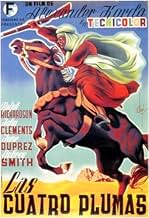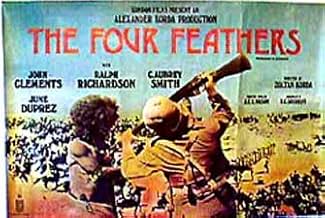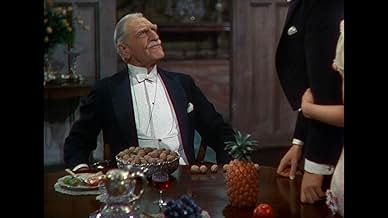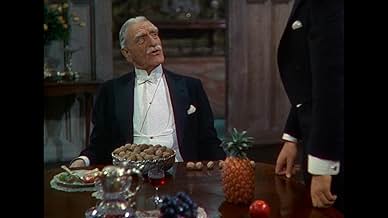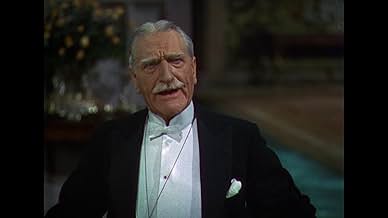AVALIAÇÃO DA IMDb
7,4/10
6,9 mil
SUA AVALIAÇÃO
Um tímido oficial do Exército Britânico de 1880 demite-se, queimando a sua convocação do último dia para a guerra no Sudão.Um tímido oficial do Exército Britânico de 1880 demite-se, queimando a sua convocação do último dia para a guerra no Sudão.Um tímido oficial do Exército Britânico de 1880 demite-se, queimando a sua convocação do último dia para a guerra no Sudão.
- Direção
- Roteiristas
- Artistas
- Prêmios
- 1 vitória e 2 indicações no total
Peter Cozens
- Man
- (não creditado)
Avaliações em destaque
In 1885 the rebellious army of cruel Dervishes enslaved and killed many thousands of defenceless natives in Sudan . Then laid siege to Kartooum , the scanty garrison's heroic commanded General Gordon appealed for help from England , but no help reached him . The film deals about Harry Faversham (John Clemens), a British officer young man . He resigns from military army and being rejected , he is branded as a coward , receiving four feathers as symbols of cowardice by his engaged fiancée (Jane Duprez) and his three comrades friends . Determined to save his honour , he heads towards Suakin on the red sea (Sudan) . His purports are the helping his friends from uprising ¨Madih¨ who had defeated to General Gordon (deeds narrated in ¨Karthoun¨ by Basil Dearden with Charlton Heston and Laurence Olivier) . He's determined to prove his courage and retrieve the lost honors . Meanwhile , the Kitchener army heads for Ondurman to fight against the Dervishes and Fuzzy Whuzzi rebels .
This is the best version of A.E.W Mason novel and contains a plethora of adventures , heroism, a love story and breathtaking battles. John Clemens as brave hero is memorable and Jane Duprez as gorgeous heroine is charming . Ralph Richardson as the blind comrade is awesome . Touch of humor is supplied by C. Aubrey Smith as the resourceful veteran military . Special mention to cinematography in a colorful and glimmer Technicolor at charge of George Perinal . Spectacular musical score by the classic musician Miklos Rozsa . The film has been magnificently realized by Korda brothers , Zoltan (direction) , production design (Vincent) and production (Alexander Korda). Other versions of Mason novel are ¨Storm over the sand¨ (1955) by Terence Young with Laurence Harvey, Anthony Steel and Mary Ure ; 1977 Television remake with Beau Bridges , Robert Powell and Jane Seymour and last adaptation (2000) by S. Kapoor with Heath Ledger , Wes Bentley and Kate Hudson . The motion picture will appeal to adventure genre fans and classic cinema enthusiasts .
This is the best version of A.E.W Mason novel and contains a plethora of adventures , heroism, a love story and breathtaking battles. John Clemens as brave hero is memorable and Jane Duprez as gorgeous heroine is charming . Ralph Richardson as the blind comrade is awesome . Touch of humor is supplied by C. Aubrey Smith as the resourceful veteran military . Special mention to cinematography in a colorful and glimmer Technicolor at charge of George Perinal . Spectacular musical score by the classic musician Miklos Rozsa . The film has been magnificently realized by Korda brothers , Zoltan (direction) , production design (Vincent) and production (Alexander Korda). Other versions of Mason novel are ¨Storm over the sand¨ (1955) by Terence Young with Laurence Harvey, Anthony Steel and Mary Ure ; 1977 Television remake with Beau Bridges , Robert Powell and Jane Seymour and last adaptation (2000) by S. Kapoor with Heath Ledger , Wes Bentley and Kate Hudson . The motion picture will appeal to adventure genre fans and classic cinema enthusiasts .
A young English army officer resigns his commission just as war in Africa breaks out. His 3 best friends, officers all, and his fiancée each give him a white feather - the sign of the coward. Shunned & ostracized, he undertakes a mission to clear his honour & prove his courage.
This is a wonderful British adventure film, equally on a par with anything Hollywood was to produce in that golden year of 1939. Shot in color, with spare-no-expense filming in the Sudan, THE FOUR FEATHERS is a paean to the glory days of Victoria's Empire & the men who fought to build it.
Sir John Clements is excellent as the young hero. Although virtually unknown to American audiences his entire career, Sir John was a very fine actor with a warmly distinctive voice which he uses here to advantage. Sir Ralph Richardson appears, terrific as always, as one of the friends; so does John Laurie, very good as the troublesome Khalifa. Sir C. Aubrey Smith, magnificent as a curmudgeonly old general, provides the final hurdle Sir John must jump to regain his reputation.
This is a wonderful British adventure film, equally on a par with anything Hollywood was to produce in that golden year of 1939. Shot in color, with spare-no-expense filming in the Sudan, THE FOUR FEATHERS is a paean to the glory days of Victoria's Empire & the men who fought to build it.
Sir John Clements is excellent as the young hero. Although virtually unknown to American audiences his entire career, Sir John was a very fine actor with a warmly distinctive voice which he uses here to advantage. Sir Ralph Richardson appears, terrific as always, as one of the friends; so does John Laurie, very good as the troublesome Khalifa. Sir C. Aubrey Smith, magnificent as a curmudgeonly old general, provides the final hurdle Sir John must jump to regain his reputation.
This is one of the best from the now happily recovered & preserved great Korda collection(for some years blocked by much litigation)when the huge Denham Studios were on a roll,having arisen from the embers of an earlier fire. Under the sheer dedication of the hungarian Kordas, they simply couldn't fail until in the middle of what must be their most popular hit, The Thief of Baghdad,they were forced to move to the US by the outbreak of WW2. Each brother has left much to posterity. Alex, the entrepreneur was subsequently knighted for his contribution to British films. In a fascinating but poignant BBC documentary of the 70s,on the great studio's rise & fall, Elizabeth Bergner {another European import) referred to him as "a prankster". This vividly technicolored remake is splendid adventure, its Sudan locations compare well with those of Lawrence of Arabia and as in "Thief" the object of my attention had to be the beautiful, husky young June Duprez.
As in Stanley Baker's "ZULU" these giant black warriors are fearsomely portrayed with the scenes inside the primitive prison where the "dumb" spy Harry Faversham eventually finds himself are quite grim. And as another reviewer has commented, crusty Sir Aubrey as ever is the perfect & amusing retired tactician at the start & finish. A glare from under those bushy eyebrows was always enough! Great entertainment.
As in Stanley Baker's "ZULU" these giant black warriors are fearsomely portrayed with the scenes inside the primitive prison where the "dumb" spy Harry Faversham eventually finds himself are quite grim. And as another reviewer has commented, crusty Sir Aubrey as ever is the perfect & amusing retired tactician at the start & finish. A glare from under those bushy eyebrows was always enough! Great entertainment.
The 1939 version of Four Feathers deserves to be better known. It's one of those action classics like The Scarlet Pimpernel or Mutiny on the Bounty whose conflicts are as relevant to one era as another. In this case they revolve around different forms of courage and honor. A man from a prominent military family is snubbed as a coward by his fellow officers and even his fiancée when he refuses to participate in Britain's Sudanese campaign of the 1890s which he believes is imperial folly. He gradually regrets his decision and decides to make amends by secretly traveling to the Sudan to help his regiment as a spy behind enemy lines. To get away with this ruse he takes drastic steps to disguise himself as a local tribesman.
The Technicolor photography is eye-poppingly rich, at the same level as three other 1939 color classics—namely, Gone with the Wind, The Wizard of Oz and Drums Along the Mohawk. Particularly effective are the transitions from the browns and yellows of North African military outposts, with their punctuations by the red, white and blue of the Union Jack, to the deep greens of rural England. To top it off, much of the film was actually shot in the Sudan with what seems like thousands of native extras. By looks alone, sometimes it's hard to believe that this production predates the Second World War. It might have been a huge hit if it had had a Cary Grant or a Clark Cable or an Errol Flynn in the lead. As things go, John Clements is as good as can be, if not exactly bursting with charisma. Ralph Richardson gives a bravura performance as Clement's fellow officer, though he is saddled with a sequence that strains credulity beyond the breaking point. Let's just say that it takes a physically fit man longer than 30 seconds of direct exposure to the desert sun before he suffers total disorientation and unconsciousness. And if the sun can do that much damage so swiftly, then surely the flesh of the unconscious man's face, exposed for hours, would be cooked to a cinder.
C. Aubrey Smith plays his usual crusty old Brit, this time as a bombastic Crimean War veteran who complains that men are no longer men and war is no longer war. His repetitious boasting wears thin after a while. June Duprez barely registers as the female love interest.
The Technicolor photography is eye-poppingly rich, at the same level as three other 1939 color classics—namely, Gone with the Wind, The Wizard of Oz and Drums Along the Mohawk. Particularly effective are the transitions from the browns and yellows of North African military outposts, with their punctuations by the red, white and blue of the Union Jack, to the deep greens of rural England. To top it off, much of the film was actually shot in the Sudan with what seems like thousands of native extras. By looks alone, sometimes it's hard to believe that this production predates the Second World War. It might have been a huge hit if it had had a Cary Grant or a Clark Cable or an Errol Flynn in the lead. As things go, John Clements is as good as can be, if not exactly bursting with charisma. Ralph Richardson gives a bravura performance as Clement's fellow officer, though he is saddled with a sequence that strains credulity beyond the breaking point. Let's just say that it takes a physically fit man longer than 30 seconds of direct exposure to the desert sun before he suffers total disorientation and unconsciousness. And if the sun can do that much damage so swiftly, then surely the flesh of the unconscious man's face, exposed for hours, would be cooked to a cinder.
C. Aubrey Smith plays his usual crusty old Brit, this time as a bombastic Crimean War veteran who complains that men are no longer men and war is no longer war. His repetitious boasting wears thin after a while. June Duprez barely registers as the female love interest.
One of my all-time favourite films of the 30s, perhaps even ever. For me, this is my personal favourite of all the Korda brothers films, and it is a true gem of a film that shouldn't be missed.
There is very little to fault The Four Feathers. It has truly evocative location work, sweeping cinematography and rich bold colours that still look amazing. The script is tight, the story is epic and always compelling and the film is perfectly paced with some great action. Miklos Rosza's score is just outstanding, easily up there as one of his best, while Zoltan Korda directs beautifully, and the acting of John Clements, Ralph Richardson and C.Aubrey Smith is excellent.
Overall, this film is a must see for so many reasons especially for its wonderful visuals and score. 10/10 Bethany Cox
There is very little to fault The Four Feathers. It has truly evocative location work, sweeping cinematography and rich bold colours that still look amazing. The script is tight, the story is epic and always compelling and the film is perfectly paced with some great action. Miklos Rosza's score is just outstanding, easily up there as one of his best, while Zoltan Korda directs beautifully, and the acting of John Clements, Ralph Richardson and C.Aubrey Smith is excellent.
Overall, this film is a must see for so many reasons especially for its wonderful visuals and score. 10/10 Bethany Cox
Você sabia?
- CuriosidadesDirector Zoltan Korda's own remake of this film, Tormenta Sobre o Nilo (1955), re-used a lot of the battle sequences from this movie, which did not lend themselves very well to the cropping necessary to achieve the width of the CinemaScope ratio, nor did their comparative fuzziness blend well with the new footage.
- Erros de gravaçãoWhen General Burroughs is talking in the garden with Ethne, his swagger stick reverses ends.
- Citações
Harry Faversham: In England, the white feather is the mark of a coward.
Dr. Harraz: Ah, I see. Then why worry? Be a coward and be happy.
Harry Faversham: No, Doctor. I have been a coward, and I wasn't happy.
- Cenas durante ou pós-créditosOpening credits prologue: In 1885 the rebellious army of cruel dervishes enslaved and killed many thousands of defenceless natives in the Sudan, then laid siege to Khartoum. The scanty garrison's heroic commander, General Gordon appealed for help from England - but no help reached him.
- ConexõesEdited into Tormenta Sobre o Nilo (1955)
- Trilhas sonorasAuld Lang Syne
(1788) (uncredited)
Lyrics by Robert Burns, music traditional
Heard during the departure of the Regiment
Principais escolhas
Faça login para avaliar e ver a lista de recomendações personalizadas
Detalhes
- Tempo de duração
- 2 h 9 min(129 min)
- Proporção
- 1.37 : 1
Contribua para esta página
Sugerir uma alteração ou adicionar conteúdo ausente


